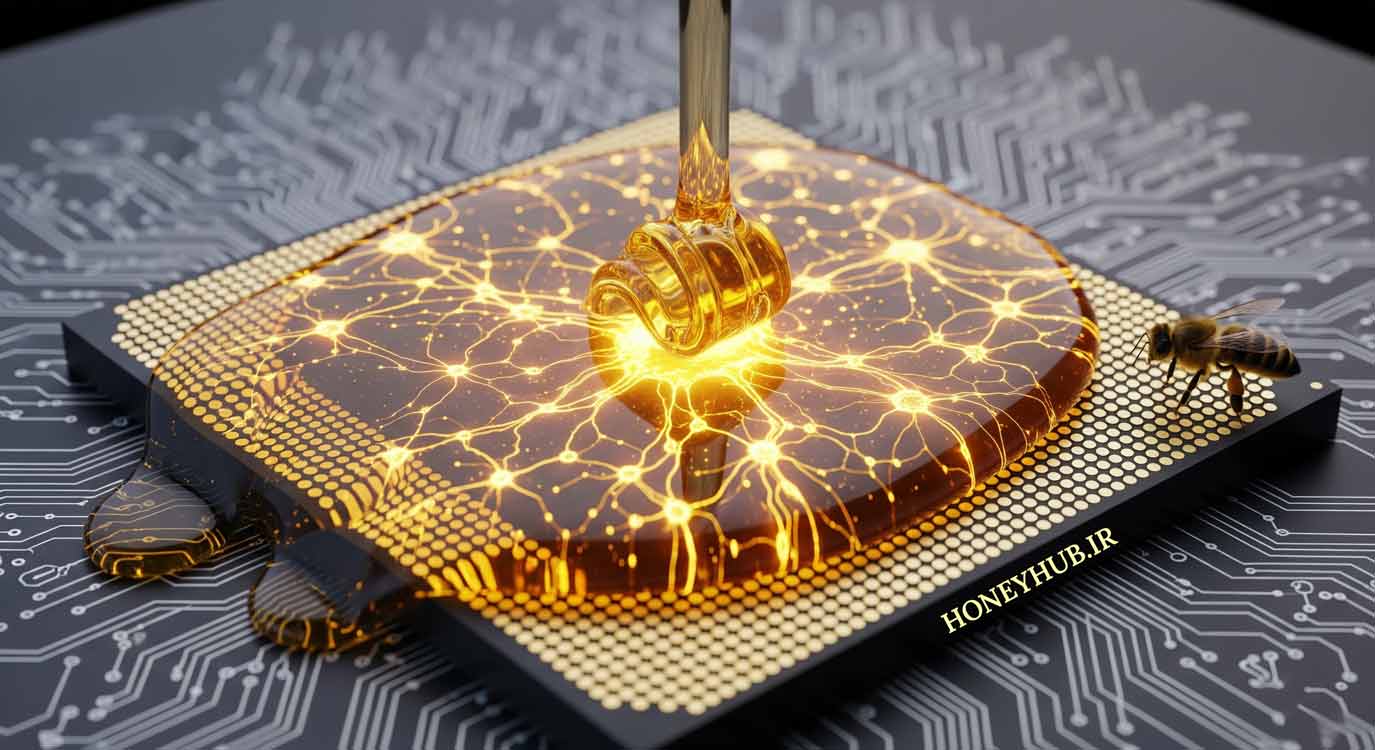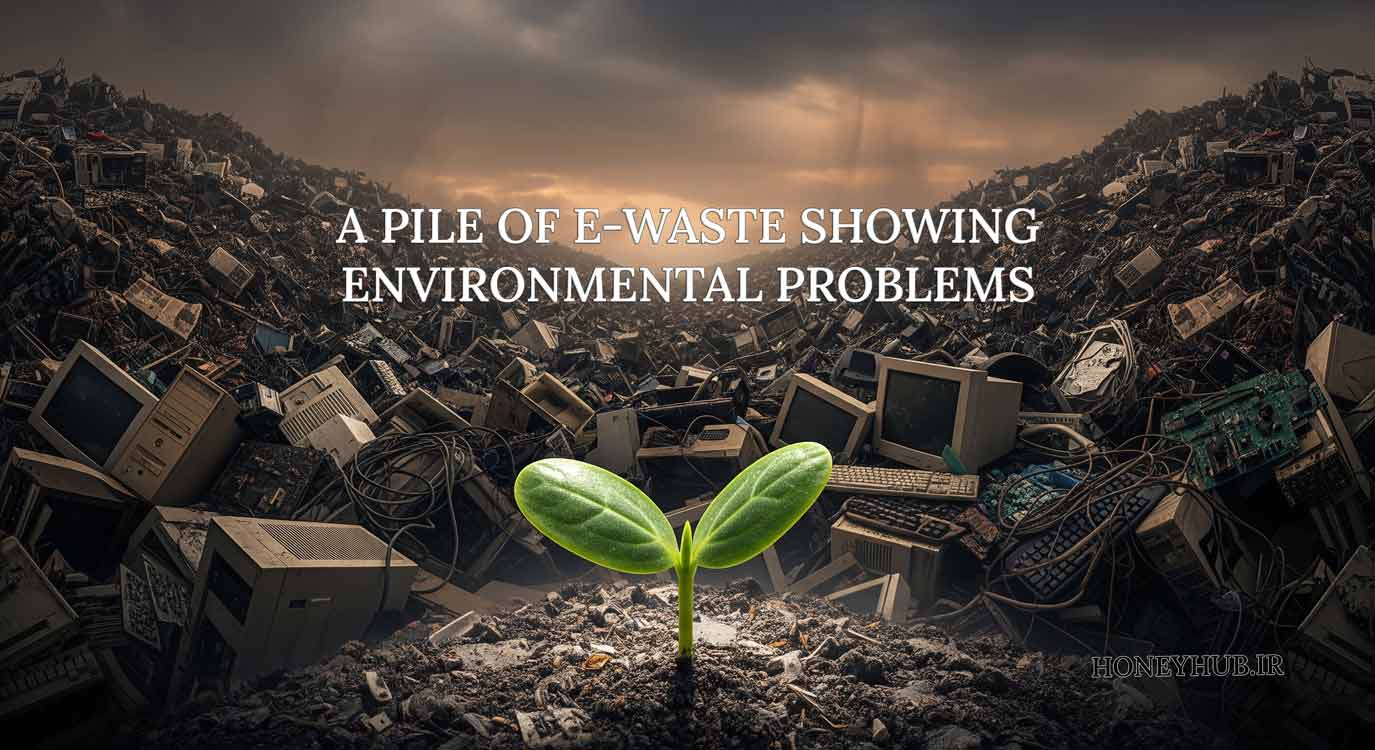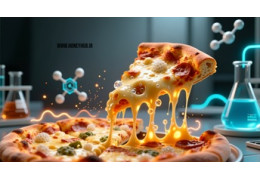Does your mozzarella refuse to stretch or just burn? The secret is science. From "pasta filata" to the crucial role...
🍯 Sweeter Than a Dream: How Honey is Rewriting the Rules of the Computer World
A comprehensive research article on the hidden crisis in the world of silicon and the emergence of an unexpected hero from the heart of nature to build the next generation of brain-inspired computers.

The Intersection of the Beehive and Silicon Valley
In a world where our lives are more intertwined than ever with the rhythm of computer processors, the idea that the solution to technology's greatest future challenges lies hidden in a beehive sounds more like science fiction than scientific fact. We live in the age of data; a world where artificial intelligence, the Internet of Things, and big data are no longer fantasy terms, but the very foundation of our economy, culture, and communication. But this amazing progress has come at a steep price. Beneath the shiny veneer of innovation, a triple crisis is brewing: the end of a golden rule, a tsunami of energy consumption, and a mountain of toxic waste. At this historic turning point, where the path of progress seems to have hit a dead end, scientists, by looking back at nature, have found an amazing answer: honey.
This article is not a short news brief; it is a deep dive into the heart of this silent revolution. We will first unveil the fundamental challenges of modern computing, from the physical limitations of silicon to its devastating environmental footprint. Then, we will journey into the amazing world of neuromorphic computing; a paradigm that, instead of following the laws of machines, draws inspiration from the unique architecture of the human brain. Finally, we will arrive at the great discovery of engineers at Washington State University (WSU) and examine how honey, this ancient and healing substance, can become the main building block for producing chips that are not only more powerful and energy-efficient, but also completely biodegradable. This story narrates the unlikely but promising union of nature and technology, and the beginning of a new chapter for a more sustainable future.
The Silent Crisis in the Heart of the Digital World
For decades, the computer industry has advanced based on a simple and powerful prediction known as Moore's Law. This law, proposed by Gordon Moore, a co-founder of Intel, in 1965, stated that the number of transistors on a chip would double approximately every two years. This increase in density meant faster, smaller, and cheaper computers. But this golden era is coming to an end. We are hitting the walls of fundamental physics.
1. The Death of Moore's Law and Physical Limitations
Today's transistors have become so small (on the order of a few nanometers) that strange quantum phenomena have begun to cause disruptions. A phenomenon called quantum tunneling causes electrons to "leak" through the very thin walls of the transistor, even when it is supposed to be off. This leads to errors in calculations and intense heat generation. Further compressing transistors generates more heat, the dissipation of which has itself become a huge engineering challenge. Simply put, we have reached the physical limit of atoms and can no longer continue to increase power exponentially by shrinking silicon components.
2. The Energy Tsunami
You may not know it, but the world's digital infrastructure is one of the largest consumers of energy. Data centers, which host websites, social networks, and cloud services, alone consume about 1 to 2 percent of the world's total electricity; an amount greater than the electricity consumption of many countries. Training advanced artificial intelligence models like GPT-3 can require as much energy as the electricity consumption of hundreds of households in a year. This insatiable hunger for energy not only has staggering costs, but it also directly contributes to the increase of greenhouse gas emissions and exacerbates the climate crisis. The current architecture of computers is inherently energy-intensive, and as the demand for computing grows, this problem will only get bigger.
3. The Mountain of Electronic Waste (E-Waste)
Every smartphone, laptop, or server that is decommissioned becomes a toxic time bomb. Annually, more than 50 million tons of electronic waste are produced worldwide, the majority of which is not properly recycled. Computer chips contain hazardous materials such as lead, mercury, cadmium, and rare earth metals. If released into nature, these materials can seep into groundwater and soil, posing serious risks to human health and the ecosystem. The process of extracting these materials is also often accompanied by widespread environmental destruction and human rights violations. This "produce, use, and dispose" cycle is no longer sustainable, and the world is in desperate need of a green alternative.

Nature's Solution, Brain-Inspired Architecture
Faced with this triple crisis, scientists, instead of trying to further optimize a flawed system, have sought a completely new paradigm. They looked to nature to find the world's most efficient computer, and they found it: the human brain. Your brain, right now as you read this text, is performing complex calculations that challenge the world's most powerful supercomputers, all while consuming less energy than a light bulb (about 20 watts).
1. The Fundamental Difference: Von Neumann Architecture vs. the Brain
Almost all of today's computers use the Von Neumann architecture. In this architecture, the "processor" (CPU) and "memory" (RAM) are two completely separate units. To perform any calculation, data must constantly be transferred from memory to the processor, and the results sent back to memory. This constant back-and-forth creates a major bottleneck called the "Von Neumann bottleneck," which causes a severe waste of time and energy. Imagine a chef (the processor) having to leave the kitchen and go to the storeroom (memory) to get each ingredient (data). This process is very slow and inefficient.
But the human brain doesn't work this way. In the brain, processing and memory happen in the same place. Each of the brain's 100 billion neurons is both a small processor and a memory unit. They are connected to each other through 1,000 trillion connections called synapses. This parallel and distributed structure allows the brain to process a huge amount of information simultaneously and with very low energy consumption. This is the very architecture that neuromorphic computing aims to emulate.
2. The Memristor: The Missing Piece to Emulate the Synapse
To build neuromorphic computers, a new electronic component was needed that could act like a synapse. Synapses are plastic connections; meaning their connection strength changes based on past experiences, and this is the basis of learning and memory. In 1971, a theorist named Leon Chua predicted the existence of a fourth electronic component (alongside the resistor, capacitor, and inductor) and named it the memristor (Memristor = Memory + Resistor). A memristor is a resistor with memory. Its resistance changes based on the amount of current that has previously passed through it, and it "remembers" this change even after the current is turned off.
This was exactly what engineers needed to simulate a synapse. A memristor can both process data by changing its resistance and store it by maintaining that same resistance. This component is the key to overcoming the Von Neumann bottleneck and building chips that truly think like a brain. But building efficient, stable, and cheap memristors has so far been a major challenge, often requiring strange and toxic materials.
The Great Discovery at Washington State University - The Honey Memristor
This is where our story reaches its peak. A team of engineers at Washington State University (WSU), led by Professor Feng Zhao, in their search for an ideal material to build a memristor, thought of an option that humanity has known and consumed for thousands of years: honey.
1. From the Hive to the Lab: How Honey Becomes an Electronic Component
The initial idea may seem strange, but the chemical properties of honey make it a wonderful candidate. The research team first processed natural honey to turn it into a solid and stable material. They then sandwiched this solid honey as a very thin layer (the thickness of a human hair) between two metal electrodes. This simple structure formed a fully functional memristor.
When an electrical voltage is applied to this structure, the electric field causes the ions and molecules present in the honey matrix to move. This movement creates or destroys very thin conductive filaments within the honey. The creation of these filaments drastically reduces the device's resistance (ON state), and their destruction increases the resistance (OFF state). Since these filaments remain in place after the voltage is removed, the device "remembers" its state and acts exactly like a synapse. The results of this research, published in the prestigious Journal of Physics D: Applied Physics, showed that this honey memristor can switch on and off at a very high speed (around 100 to 500 nanoseconds).
"It's a very small device with a simple structure, but it has very similar functionalities to a human neuron. If we can integrate millions or billions of these honey memristors together, they can be made into a neuromorphic system that functions much like a human brain."
2. Why Does Honey Work So Well? The Chemistry Behind the Wonder
The success of honey as a memristive material is not accidental and is rooted in its unique chemical composition:
- High Concentration of Sugars: Honey is mainly composed of fructose and glucose. These organic molecules have numerous hydroxyl (-OH) groups that can play a key role in the process of ion migration and the formation of conductive filaments.
- Very Low Moisture Content: Honey is a hygroscopic substance with a very low moisture content (about 17%). This property, which prevents bacterial growth and spoilage of honey, is a major advantage in the world of electronics. Low moisture means chemical and physical stability of the device and prevents unwanted short circuits.
- Mild Acidic Properties: The presence of gluconic acid gives honey a low pH, which also contributes to its stability and antimicrobial properties and can have a positive effect on the electrochemical behavior of the device.
Professor Zhao says on this matter:
"Honey does not spoil. This means that these computer chips will be very stable and reliable for a long time."
Revolutionary Advantages; Beyond Speed and Power
The importance of honey memristors is not just summarized in their electronic performance. This technology is a paradigm shift in how we view the production and disposal of electronic devices.
1. Biodegradability: The End of the E-Waste Nightmare
This is the biggest and most important advantage. Imagine one day, instead of storing old phones in a drawer or throwing them in the trash, you could dissolve their main electronic components in a glass of water. This is exactly the vision that honey chips promise. Since the active material of these chips is completely natural and organic, they can be easily dissolved in water at the end of their useful life without harming the environment. This technology has the potential to turn mountains of e-waste into a distant memory and bring the electronics industry into a true Circular Economy.
2. Sustainability and Renewability: From the Mine to the Hive
The production of silicon chips requires the extraction of silica from mines, purification at very high temperatures, and complex and energy-intensive chemical processes. Many other components also require rare earth metals, the extraction of which is often associated with environmental and social damages. In contrast, honey is a completely renewable resource. Honey bees, these little engineers of nature, not only produce honey, but also play a vital role in maintaining biodiversity and producing agricultural products through pollination. Moving towards honey-based electronics means supporting a healthy ecosystem instead of destroying it.
3. Challenges and the Road Ahead
Of course, the path from a laboratory memristor to a commercial computer is full of challenges. The first challenge is scalability. Building billions of nanoscale honey memristors on a single chip requires the development of very precise manufacturing techniques. The second challenge is uniformity. The chemical composition of natural honey varies slightly depending on the type of flower, geographical region, and season. for mass production, researchers must find a way to standardize the raw material (perhaps by using a type of artificial or processed honey) so that all memristors have the same performance. Finally, the issue of stability in different environmental conditions must also be examined. Although these devices have led to the humorous warning "don't spill your coffee on it," their resistance to environmental humidity and temperature must be precisely engineered.
| Feature | Honey-based Chip (Neuromorphic) | Silicon-based Chip (Von Neumann) |
|---|---|---|
| Main Material | Honey (organic and renewable) | Silicon (mineral and requires heavy processing) |
| Architecture | Neuromorphic (integrated processing and memory) | Von Neumann (separate processing and memory) |
| Energy Consumption | Very low, similar to the brain | High, due to the Von Neumann bottleneck |
| End of Life | Completely biodegradable (soluble in water) | Toxic and hazardous electronic waste |
| Source of Inspiration | Human brain (biological system) | Calculator (mechanical system) |
The future is sweet, just like our honey!
As you've read, nature is the inspiration for the greatest innovations to build a better and cleaner future. Every drop of honey is not just a simple sweet, but a treasure trove of complexity, sustainability, and energy. We, too, with love and respect for this very nature, bring you the purest and most natural honeys from the pristine plains of Iran.
Maybe your computer chip doesn't run on honey yet, but why not your health and energy! Taste the power of nature with every spoonful of our honey. By buying natural honey, you not only invest in your health, but you also support dedicated beekeepers and an industry that is key to the sustainability of our ecosystem.
Order the taste of pure nature nowConclusion
The discovery of honey's capabilities in making computer chips is more than just a fascinating innovation. It is a sign; a sign of a profound change in the philosophy of technology. We are moving from an era where technology was achieved at the cost of destroying nature, to an era where technology is inspired by and cooperates with nature. This is an emerging branch called green electronics or sustainable electronics, in which materials like cellulose, proteins, and now honey, are replacing toxic and unsustainable materials.
The road ahead is long, but the vision is very bright: a world where our electronic devices are as efficient as the human brain and as compatible with nature as a beehive. Perhaps one day not too far away, the world's most powerful supercomputers will owe their existence to the efforts of nature's smallest engineers, the honey bees, and this will be the sweetest victory for science and the Earth.
📚 References
This comprehensive article is based on credible scientific and news reports and research:














Latest comments